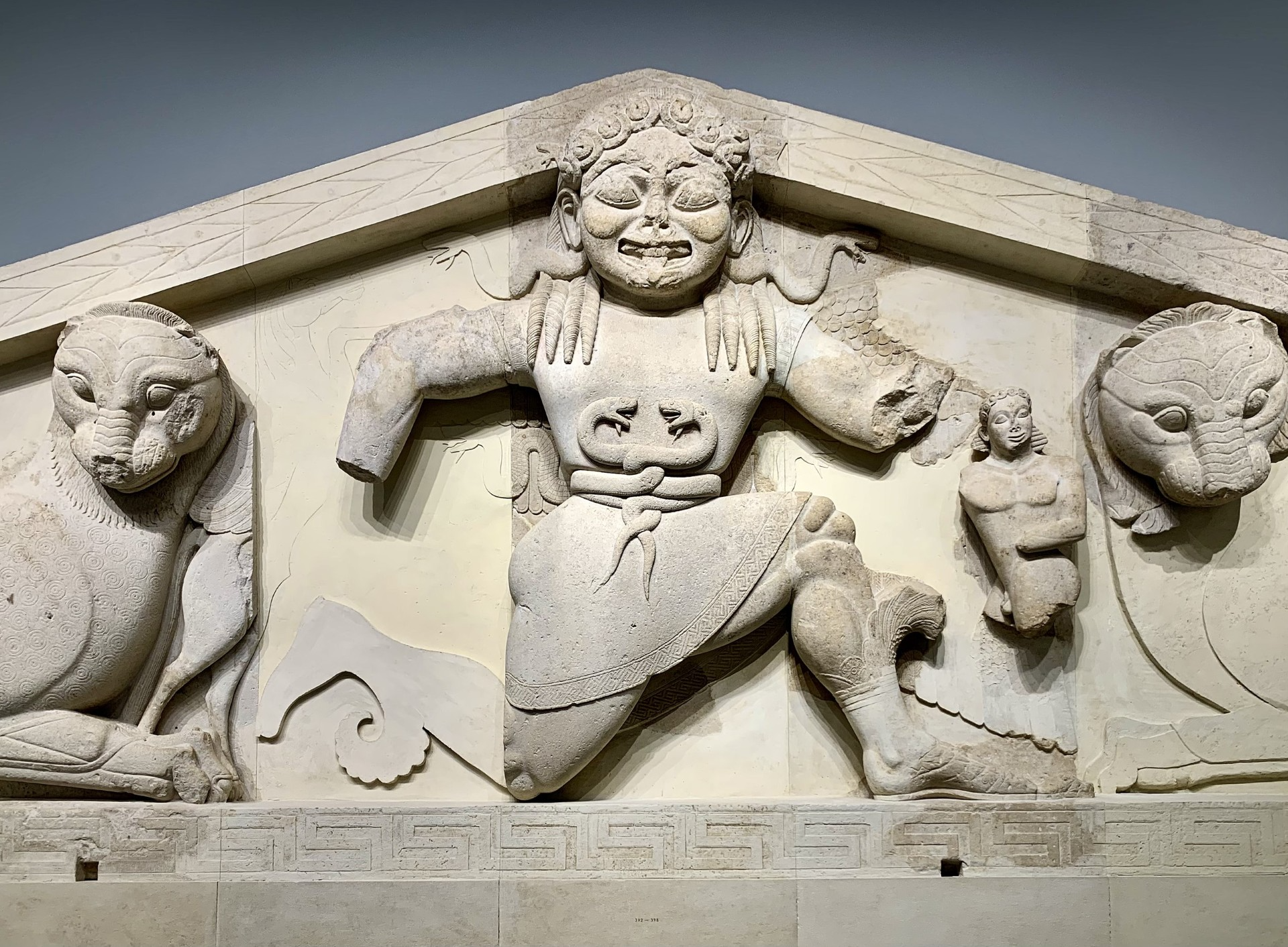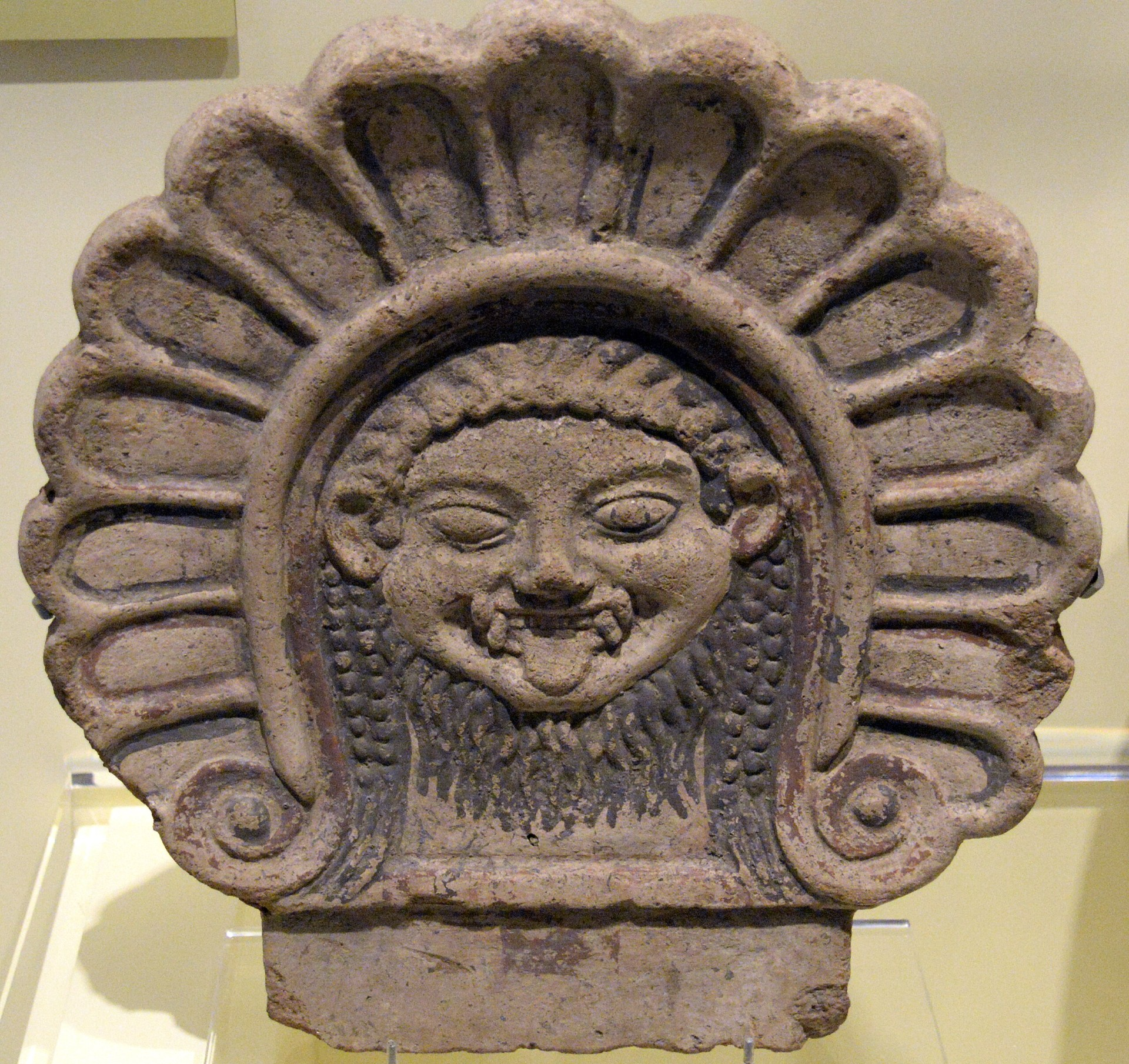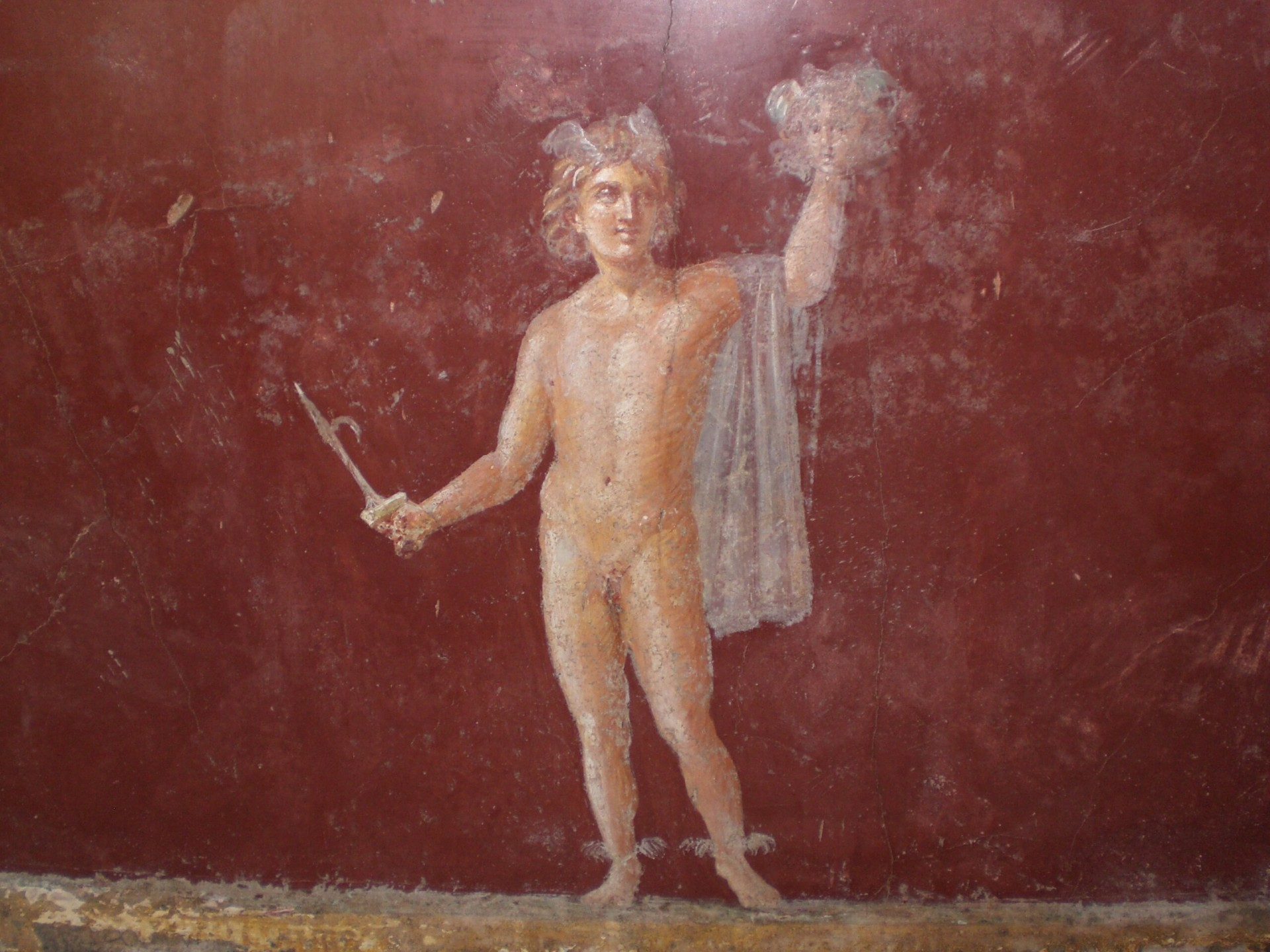Everyone wants to lay claim to Medusa—the legendary mortal Gorgon with snakes for hair, whose petrifying stare would turn onlookers into stone. Psychoanalysts argue that the serpents entwined in her hair symbolize the male fear of castration, while feminists have embraced her as one of their own and view her as an avenging figure who empowers women to reclaim their narratives. French philosopher Helene Cixious, in her essay “The Laugh of the Medusa,” contends that Medusa’s otherness is emancipating, not hideous, whereas author and mythologist Joseph Campbell integrates her myth into the decline of ancient matriarchal cultures. Spotlighting her enduring influence over millennia, she has inspired poets, artists, and filmmakers and even serves as a cultural icon for a major fashion house, all while operating as a figure of revolt for political theorists. Much like the serpents that encircle her, Medusa’s multiple personalities represent an intricate patchwork of identities and narratives.
Cursed to a fate to which she fell victim, Medusa’s true story remains untold. Often derided within Greek mythology and outside of it, she is overwhelmed by misfortune and misunderstanding, but beneath her monstrous exterior lies a complex tapestry woven from the threads of beauty, transformation, and victimization. Once told, her story deserves sympathy rather than scorn… So let us examine the realm of Medusa. Although the reflections of Graeco-Roman society are apparent in the narratives, do the myths also offer information about Medusa’s true origins? Routinely portrayed as an outsider, might the snakes that encircle her reveal clues about origins that extend beyond the confines of the Greek world?

Medusa first appears in one of Greek mythology’s oldest stories. In his Theogony (8th-7th century BCE), Hesiod informs that she was the only mortal of the three demon-like sisters known as the Gorgons. The other two Gorgon sisters were Sthenno and Euryale; most traditions depict them as having snakes for hair like Medusa and sometimes boar-like tusks and wings. Unlike Medusa, the Gorgon sisters were immortal, thus always young. The Gorgons, along with other sea creatures, are the children of Phorcys and Ceto, who are among the oldest deities of the Greek pantheon, springing from Gaia—the earth herself—and her son Pontus, who represented the sea. As primordial sea gods, the fish-tailed Phorcys and Ceto were both siblings and consorts who ruled over enormous sea creatures and the ocean’s unfathomable depths, reflecting the Greeks’ fear of the sea’s many lurking dangers.
Soon after Hesiod introduces Medusa, he recounts her tragic fate. Being born mortal into a family of immortals was bad enough, but then “the Dark-haired One (Poseidon—god of the sea, storms, earthquakes, and horses) lay down with her among the flowers of spring in a soft meadow.” Although Hesiod does not state it explicitly, whenever a god lies with a mortal in the Greek world, one can expect that rape or, at the very least, coercion is involved. After enduring his predatory advances, Medusa becomes impregnated with Poseidon’s progeny. Poor Medusa, she can’t catch a break; she then becomes the unfortunate target of a self-serving hero.
The next line states, “So when Perseus later cut off her head, enormous Chrysaor sprang out, along with Pegasus, the horse.” Losing her head, however, is not the only way Medusa is cursed. First, she is regarded as a foreigner by the Greeks due to the misfortune of being born a Gorgon, and secondly, as a female, Medusa loses her place in society when her chastity is taken, as only chaste, obedient, and demure women were respected in the Greek world. Because of her diminished status, the myth never questions the morality of slaying an innocent female, even while she is in a pregnant state.

Medusa is not heard from again until the fifth century BCE, when Pindar, the renowned Greek lyric poet, mentions her briefly in his Pythian Ode 12. But like all myths about Medusa, the myth is more about Perseus’s heroic quest than it is about the unfortunate snake-haired maiden. Nevertheless, in Ode 12, Pindar recounts how when Perseus—son of Zeus and the mortal princess Danae—”stripped off the head of beautiful Medusa,” Medusa’s sisters hunted him down. When they were unsuccessful in apprehending him, they wailed a mournful dirge on behalf of their deceased sister, highlighting the profound bond between the Gorgon sisters and underscoring the tragic nature of Medusa’s fate. In particular, Euryale’s lamentation was so compelling that Athena herself is said to have crafted the aulos (flute) to mimic her sorrowful tune.
The next time we hear from Medusa is when the author, known as Pseudo-Apollodorus, addresses her in a text entitled Bibliotheca (The Library), dating to the 1st or 2nd century CE. Yet again, Medusa, is a mere plot device on a hero’s adventurous journey which overshadows her complexity and agency.
In the myth, Perseus finds himself in conflict with a king, specifically Polydectes of Seriphus. In order to remove Perseus, who is an unwanted obstacle in his pursuit of his mother Danae, Polydectes sends him on a quest to decapitate Medusa, fully aware that it is a futile endeavor certain to result in the hero’s demise. Although the odds are stacked squarely against him, he sells Perseus on the notion that if he succeeds in his quest, he’ll obtain endless fame.
Polydectes, however, is unaware that Perseus’s father is Zeus—lord of the Olympian gods—thus he receives divine help from his half-siblings, the Olympians. Athena, goddess of wisdom and warfare, and the messenger god Hermes, equip Perseus with some essentials for his quest. From Hermes, he receives a curved sword designed to effectively sever Medusa’s head, and from Athena, a polished shield allowing him to observe Medusa without making direct eye contact with her, thus preventing his petrification. The Olympians also advise him to consult the Gorgons’ sisters, the three Phorcides, who were born old and share a single tooth and eye between them. Perseus, ever-cunning, takes possession of both tooth and eye and refuses to release them until the Phorcides reveal the Gorgons’ location. Sufficiently coerced, the sisters acquiesce, and they also provide Perseus with instruments that seal their poor sister’s fate: Hades’ cap of invisibility, which enables him to see everything without being seen; winged sandals to fly outside the boundaries of the Greek world where the Gorgons reside; and a kibisis, a magic bag, in which to place Medusa’s severed head.
Once Perseusis armed to succeed in his quest,, he stands over a sleeping Medusa, and “…Athena guides his hand; he looks with an averted gaze on a brazen shield, in which he beholds the image of the Gorgon, and then he beheads her.” Perseus, the so-called hero, lacks the courage even to gaze directly upon Medusa’s sleeping face, even when her eyes are tightly shut. In this inverted tale about a hero and a monster, the hero is the monster: a cowardly figure who slays a defenseless, expectant maiden solely for the sake of fame. In contrast, despite the misfortune of being born a Gorgon, the monster, who has committed no wrongdoing, is perhaps the true hero of the story; she displays a quiet sort of heroism in having to endure the injustice of the savagery used against her.
Upon Medusa’s death, her offspring, Pegasus and Chrysaor, arise from her, while Perseus appropriates her head which then becomes a weapon, forced to safeguard its slayer. With its deadly stare, Medusa’s head becomes a formidable weapon for Perseus, enabling him to turn his enemies into stone.

Thus equipped, a triumphant Perseus completes his mission and presents Medusa’s head to Athena, who places it at the center of her shield to help fend off her many enemies. To keep their foes in check, Greek soldiers, like Athena, adorned their shields with the serpent-haired Gorgon, characterized by its protruding tongue and bulging eyes. In this manner, Medusa was an apotropaic object, serving as a deterrent against the evil it embodies. Similarly, the Greeks featured Medusa’s image on entryways to deter unwelcome intruders. Although her appearance was unlucky for Medusa, for the Greeks, it is a talisman against assaults, both statewide and domestic.
Of all the cruel accounts of Medusa’s wretched fate, Ovid’s is arguably the cruelest. The best known mythological narrative of her life comes from his Metamorphoses, completed before his banishment by Augustus in 8 CE. In this story, Medusa is depicted as a beautiful young maiden with lustrous hair who serves as a priestess for Minerva. To the Romans, Minerva corresponds to Athena, the goddess of wisdom and warfare; Neptune aligns with Poseidon, the lord of the sea and earthquakes; and Mercury is Hermes, the herald god of communication.
As is the case in most Graeco-Roman myths, Medusa’s beauty would prove most deleterious to her. One day, while Medusa is ministering in Minerva’s temple, Neptune—always one for a pretty face—swoops down from his home on Mount Olympus and has his way with her. In Ovid’s rendition of the myth, Perseus recounts Medusa’s woeful tale to guests at his wedding to Andromeda: “Her beauty was far-famed… and of all her charms, her hair was the loveliest… She, it is said, was violated by Ocean’s lord.”
When the virgin goddess Minerva learns that her temple has been desecrated, instead of punishing the offender—her dear old Uncle Neptune—she punishes the victim. In Greek or Roman mythology, it is common for female victims of rape to face punishment, transformation, or exile, while the perpetrators, often gods, remain uncondemned. Such perverse justice exemplifies the patriarchal values of a society where males are frequently absolved of their transgressions against the fairer sex.
Because Medusa was known for her luminous hair, Minerva replaces it with writhing snakes. “For Jove’s (Zeus’s) daughter turned away and covered with her shield her virgin eyes, and then for fitting punishment transformed the Gorgon’s lovely hair to loathsome snakes.” Ever a water carrier for the patriarchs, like the Greeks before him, Ovid makes sure that Minerva is no friend to females. The harsh sentence Ovid has Minerva impose on Medusa, the victim, reflects the hyper-patriarchal Roman attitude toward women. An important theme in this narrative is the tendency for powerful males to perpetrate crimes against subordinate females and then to accuse and punish the female victims. The transformation and subsequent exile of Medusa mirror the Roman (and earlier Greek) propensity to punish women who were considered violating societal standards, even when they were innocent.
Even more wickedly, however, the ruthless Minerva curses Medusa to appear so hideous that she is doomed to a lifetime of turning anyone she looks at into stone. Hence the society that once enjoyed gazing on Medusa’s beauty is now afraid to look upon her disfigurement lest they perish. Through no fault of her own, Medusa is forced into a lifetime of seclusion evolving from a victim of divine injustice into a creature feared by anyone who has the misfortune to behold her.
In all the myths, regardless of the era or tradition, Medusa—who embodies both femininity and otherness—evokes no sympathy, even while pregnant. Her peculiarity and monstrosity isolate her from humanity, rendering her an inherently dangerous presence that exists beyond the confines of the Greek world. For many, Medusa is viewed as the ultimate figure of the other; not only is she a foreigner, but she is also a powerful female who must therefore be subdued or controlled. In the hyper-patriarchal and xenophobic Graeco-Roman worldview, Medusa’s very existence is seen as a threat that necessitates eradication because she does not conform to the narrow criteria of a society that values women who embody the often contradictory principles of being both visually appealing and chaste.
Because the various myth traditions consistently portray Medusa as an ‘other’ who resides out of their sphere, could Medusa’s true roots lie outside the Greek world? To answer that question, it is important to understand the connection between mythology and history, as it is widely acknowledged that mythology has a historical dimension. Myths act as a form of cultural memory, preserving important past experiences which shape group identity over generations. When we consider the myths around Medusa, it is useful to view them with a historical lens.

Hesiod, in the eighth century BCE begins the vanguard, which includes several ancient chroniclers who trace Medusa’s pre-Hellenic origins to the region that the Greeks referred to as Libya. For the Greeks, Libya encompassed the entire area of North Africa west of the Nile River, extending from the Strait of Gibraltar to western Egypt and including what is now present-day Libya, Tunisia, Algeria, and Morocco. In his Library of History, Diodorus Siculus (c. 90-20 BCE) offers extensive details about Medusa’s background: “The Gorgons, they say, were a people dwelling not far from the Amazons and were ruled by women…Medusa, who was the queen of these people, surpassed her fellows in beauty and in the vigor of her body and in her ability in warlike exploits. But she was slain by Perseus, who, after he had cut off her head, carried it with him to Greece.”
We refer to myths featuring heroes who defeat dragons, gorgons, serpents, and other monstrous entities as narratives of expulsion. In these stories, the great goddesses or powerful females from indigenous religions are often depicted as terrifying figures who endure various forms of violence, including rape, decapitation, or annihilation—sometimes experiencing all three, as illustrated in the Graeco-Roman myths of Medusa. Medusa’s tragedy serves as a means of coercing a population, reflecting societal concerns and highlighting the devaluation of feminine strength. These narratives reinforce patriarchal principles by portraying goddesses as grotesque figures, undermining the complexity of feminine divinity, and reducing the great goddesses to mere symbols of danger that necessitate domination.
Today, many scholars argue that the Gorgons were historical Libyan Amazons and that Medusa embodied a powerful figure in a time and region marked by female dominance. Was she merely a Gorgon queen, as Siculus suggests, or did her influence extend even further, as some historians now contend? Her emblem—a female face crowned with serpent hair—functioned as a widely recognized symbol of divine feminine wisdom in the region. Notably, in matriarchal or matrilineal religions, snakes represented fertility and resurrection and were associated with wisdom and female power; the matrilineal religion celebrated serpents, which explains why they were often derided in the Graeco-Roman tradition.

Medusa, however, is not the only figure from Libya present in Greek mythology; even the patriarchal Olympian goddess Athena—who frequently appears in the Medusa myths—was once a powerful goddess closely connected to the region. Known as the Triple Goddess, Medusa and Athena were two members of a triad that also included Metis; Medusa embodied the destroyer or underworld aspect of the Triple Goddess, while Athena represented the maiden warrior. Metis completed this trio by symbolizing motherhood or the nurturing side of the goddess.
Although Greek colonization of the region known as Libya took place in the 7th century BCE, interaction and cultural exchange between the two societies began long before. Written records emerge in the 8th century BCE, when Hesiod, in one of the earliest recorded myths, places the Gorgons in the far West: “beyond glorious Ocean at the edge towards the night.” Reflecting their practices throughout the pre-Hellenic world, the Greeks appropriated indigenous goddesses, leading to the creation of new myths that transformed these powerful figures into subaltern characters, relegating them to roles as wives, sisters, and daughters—and, in the case of Medusa, a monster.
Medusa’s odyssey illustrates her transformation from a once-revered goddess of an indigenous population to an oppressed figure condemned in the Graeco-Roman tradition. Her story reflects the experiences of many who have fallen victim to misogyny and victim blaming, remaining as relevant today as it was when crafted by the ancients. Nonetheless, her enduring significance has transformed Medusa into a cultural and global icon of female empowerment, much like her indomitable spirit as it was envisioned in ancient Libya over three millennia ago.
